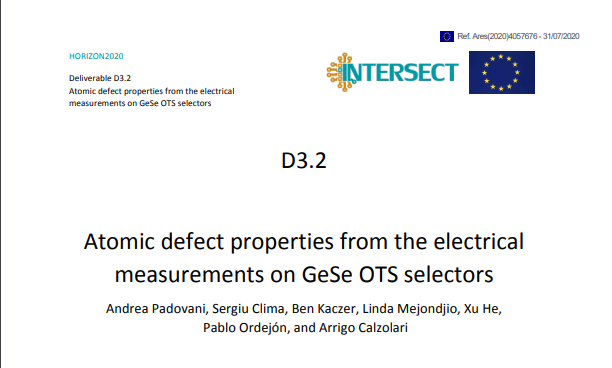
26 Aug #Deliverable 3.2 “Atomic defect properties extracted from the electrical measurements on OTS selectors”
As we recently posted, new INTERSECT project deliverables are out! Deliverable 3.2 “Atomic defect properties extracted from the electrical measurements on OTS selectors“, by our intersecters A. Padovani, S. Clima, B. Kackzer, L. Medondjio, X. He, P. Ordejón, and A. Calzolari, is developed within Work Package 3, “Testing and piloting”, and its task n. 3.3., “From OTS selector electrical characteristics to key material/defect properties”, with AMAT as task leader and contributions from CNR, ICN2, FMC, IMEC.
Abstract: This document provides a description of the use of the device cycle of the IM2D Simulation box to extract material and defect properties from the interpretation of the electrical current-voltage (I-V) characteristics measured on Ovonic Threshold Switching (OTS) selector devices. The task activities rely on the use of the Defect Discovery Tool (DDT) functionalities implemented into AMAT proprietary GinestraTM platform, that are specifically developed to extract intrinsic material/device properties (bandgap, thicknesses) and characteristics of the defects (thermal ionization and relaxation energies, distribution within the bandgap) from electrical measurements. Further details on DDT can be found in Sec 3.2 of Deliverable 3.1.
DDT functionalities are applied to current-voltage and conductance-voltage (G-V) characteristics measured on GeSe-based OTS devices with different thicknesses (10nm and 20nm) and compositions (Ge60Se40 and Ge50Se50). Capacitance-Voltage characteristics (C-V) are used to provide an estimation of the relative dielectric permittivity of the GeSe film. All devices and electrical measurements are provided by the IMEC unit.
Consistent results are obtained for all the considered samples. Derived material parameters (band-gap and relative dielectric permittivity) well agree with reports in literature and with the Density Functional Theory (DFT) calculations performed within the project and presented in this Deliverable. An increase of GeSe band-gap is observed as the Ge content of the film is reduced (from Ge60Se40 to Ge50Se50).
The experimental I-V characteristics and their temperature dependence are well explained by a trap-assisted carrier transport, occurring through a defect-band located close to the GeSe valence band minima. The traps energy levels (within the band-gap) extracted with the DDT functionalities are found to be in good agreement with the values reported in Selenium vacancies (VSe) literature. However, a precise identification of the defect atomic structure is not straightforward, since the value of the relaxation energy cannot be unambiguously identified.
Info & download: A. Padovani, S. Clima, B. Kackzer, L. Medondjio, X. He, P. Ordejón, and A. Calzolari (2020): Atomic defect properties from the electrical measurements on GeSe OTS selectors. Deliverable D3.2 of the H2020 project INTERSECT (final version as of 28/07/2020). EC grant agreement no: 814487, Applied Materials, Reggio Emilia, Italy.



Sorry, the comment form is closed at this time.